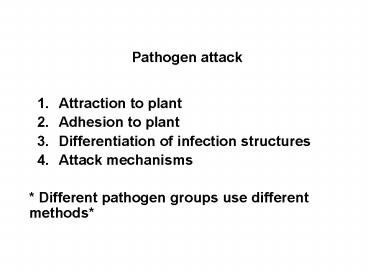Pathogen attack - PowerPoint PPT Presentation
1 / 32
Title:
Pathogen attack
Description:
Germtube Septoria tritici growing through stomata. Adhesion to Plant - nonspecific ... Galls - growth regulation. altered genetic control. Agrobacterium tumefaciens ... – PowerPoint PPT presentation
Number of Views:768
Avg rating:3.0/5.0
Title: Pathogen attack
1
Pathogen attack
- Attraction to plant
- Adhesion to plant
- Differentiation of infection structures
- Attack mechanisms
Different pathogen groups use different methods
2
Attraction to plant
Pratylenchus attracted to root hairs
3
Zoospores swim to nutrients
Drop sugar
Microscope slide
4
Germtube Septoria tritici growing through stomata
5
Adhesion to Plant - nonspecific
- Magnaporthe grisea conidia - tip mucilage
(glue)
Glues the spore to the hydrophobic rice surface
through rain or dew, which are critical for
penetration.
- Mistletoe viscin
Micrographs by Rick Howard Lab, DuPont
6
Adhesion to Plant - specific
Ghigo lab, Pasture Institute
7
Adhesion to Plant - specific
OToole lab, Dartmouth
Ghigo lab, Pasture Institute
8
- Polysaccharides
- Cellulose (NOT Erwinia chrysanthemi)
- Agrobacterium tumefaciens
- Salmonella enterica
- Pathogenic E. coli
- Poly-b-1.6-n-acetyl-d-glucosamine
- Colanic acid (NOT S. enterica)
- Adhesins
- Fimbriae
- Curli
- Type 3 Secretion System
- Flagella
- Pathogenicity complex
- Enteric bacteria
9
Adhesion to Plant - specific
10
N-acyl homoserine lactone (AHL)-mediated quorum
sensing
- Cells in aggregates have a greater ability to
survive desiccation stress - Increased tolerance to desiccation is related
directly to the size of the cell aggregate - Is leaf fitness cell-density-dependent?
AHL signal
regulator
11
Differentiation of infection structures (fungi)
- Physical (thigmotropism) or chemical stimulus
from plant leads to differentiation - Thigmotropism
- Powdery Mildew gt junctions of epidermal cells
- Puccinia spp. gt leaf surface topography
- Uromyces phaseoli gt height of lip of a stoma, 0.5
µm
12
Transmembrane protein secretion machinery
Marlovits, et al., 2004
13
Attack Mechanisms
- a. Destruction of Structural Integrity
- b. Altered Host Metabolism
- c. Altered Genetic Controls
- d. Interference with Transport (translocation and
transpiration)
14
Destruction of Structural Integrity
- Enzymatic degradation of host
- Enzyme name often ends in ase
- Endopolygalacturonase gt attacks polymers of
galacturonic acid. Endo indicates attack of
internal part of galacturonic chain. - Exopoly gt ends of the polymer
- Lyase, splits polymer by removing water
15
Plant Cell Walllipid and sugar polymers with
imbedded proteins
CW layer
Biochemical composition
Pathogen tool
16
Other enzymes
- Proteinases
- Amylases - starch
- Lipases, phospholipses - oils, fats, membranes
17
Cellulose
b 1-4 D glucan chains held together by hydrogen
bonds
18
Mixed linked b glucans
19
Why make cellulose AND cellulase?
20
Pectin structure and where enzymes attack
galacturonic acid
rhamnose
arabinose
galacturonic acid
21
Erwinia soft rots
- 2 cellulases
- 8 endopectate lyases
- 1 Exopectate lyases
- 1 Pectin acetylesterase
- 2 Pectin methylesterases
- 3 Pectin lyases
- 1 Polygalacturonase
- 1 Rhamnogalacturonate lyase
- 3 Endopolygalacturonases
22
Altered Host Metabolism
- Phytotoxins low molecular weight compounds
produced by pathogen and toxic to host - Host specific
- Non host specific
- Detoxification
- Growth Regulators
- avr and Type III Secretion
23
Phytotoxins, Host Specific
- Victorin
- Cochliobolus victoria, Victoria Blight of Oats
- inhibition of glycine decarboxylase, involved in
photorespiration - T-toxin
- Cochliobolus heterostrophus, race T southern corn
leaf blight - uncouples electrolyte gradient in mitochondria
- HC toxin
- Cochliobolus carbonum, Carbonum leaf spot of corn
- inhibition of histone deacetylase
- Ptr toxin
- Pyrenophora tritici-repentis, tan spot of wheat
24
Tan Spot of Wheat Pyrenophora tritici-repentis
Courtesy of Dr.William Bockus, Kansas State Univ.
25
Toxin alone causes chlorosis on susceptible wheat
Lines
Katepwa S Chl
6B365 R
fungus
Glenlea R
Salamouni R
S Chl
R
Prt toxin
R
R
S Control
26
Pyrenophora tritici-repentis isolates lacking the
Prt gene are less virulent on susceptible wheat
Susceptible wheat
R wheat
27
Phytotoxins, Non Host Specific
- Tabtoxin
- Pseudomonas syringae pv. tabaci, wildfire disease
of tobacco - Glutamine synthetase gt toxic conc ammonia
- Phaseolotoxin
- Pseudomonas syringae pv. phaseolicola, halo
blight of bean - Ornithine carbamoyltransferase gt alters amino
acid pools and inhibits pyrimidine biosynthesis - Pyricularin
- Pyricularia (Magnaporthe) grisea, rice blast
disease - Tentoxin
- Alternaria alternata, seedling disease
- Disrupts chloroplast development and inhibits
polyphenol oxidase - Cerato-ulmin
- Ophiostoma ulmi, Dutch elm disease
28
Coronatine Pseudomonas syringae pv. tomato
Stomata
Guard Cells
CLOSED
29
Growth Regulators
- Can be formed or induced by pathogen
- Auxins (cell elongation)
- Pathogen derived inhibitors of auxin
- Cytokinins (cell division)
- Mistletoes on conifers
- Gibberellins (cell elongation)
- Gibberella fujikuroi, foolish seedling disease of
rice - Elsinoë brasiliensis, superelongation disease of
cassava - Ethylene (many functions)
- Implicated in premature defoliation of some
plants diseases
30
Giant cell formation by Melodigyne
Female nematode
31
Galls - growth regulationaltered genetic control
Agrobacterium tumefaciens
32
Interference with Transport
- Plugging vascular tissues
- Wilting
- Pathogen
- Mycelium and spores
- Extracellular polysaccharide (EPS)
- May mask elicitors of resistant response
- Host
- Tyloses (Overgrowth of the protoplast of a
parenchyma cell into an adjacent xylelm vessel or
tracheid), gums, gels - Girdling by cankers
- Root damage
- Nematodes
- fungi





![About Nuclear, biological, and chemical [NBC] Attack? PowerPoint PPT Presentation](https://s3.amazonaws.com/images.powershow.com/10003306.th0.jpg?_=20240224121)

























